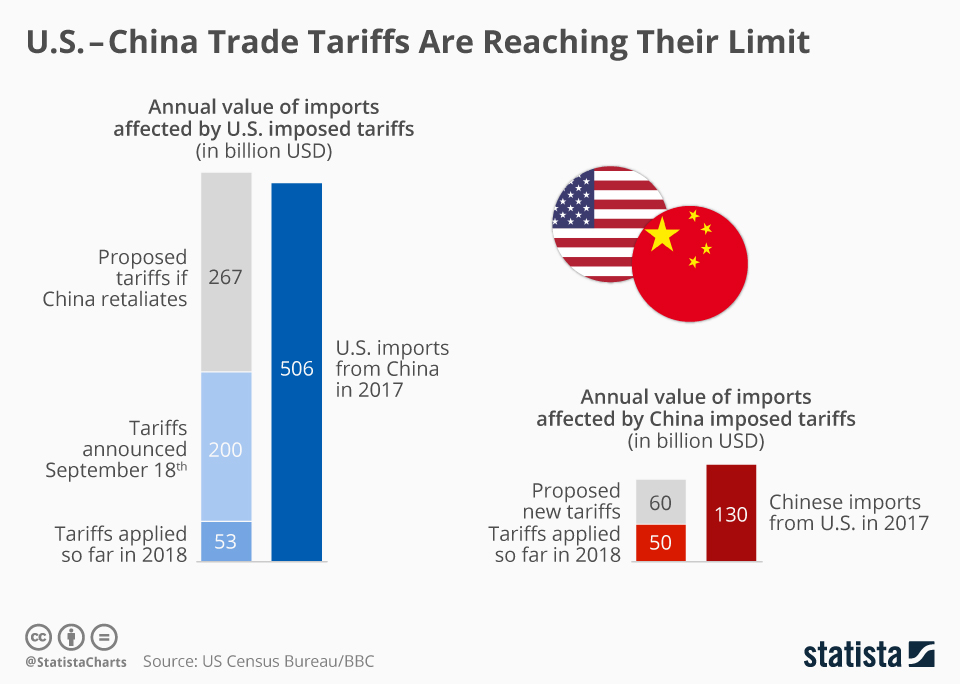The impacts of China tariffs are set to reverberate through the global economy, sparking intense discussions about their potential ramifications. As the ongoing US-China trade war escalates, concerns over the tariffs’ economic effects loom large, particularly for American consumers. These levies could lead to significant supply chain disruptions that once reliably supported businesses both stateside and across the Pacific. While Beijing aims to stabilize its already fragile economy, the unintended fallout for the U.S. may include skyrocketing prices and diplomatic rifts with key allies. As such, analyzing the interplay of tariffs and their broader implications is critical for understanding the future of international trade.
Examining the repercussions of tariffs imposed on Chinese goods reveals a complex interplay of economic forces at work. As trade tensions between the United States and China intensify, questions flourish regarding the broader economic environment. The potential fallout from these measures could lead to severe economic consequences for American consumers and create ripples in global supply chains. Moreover, the ongoing trade conflicts raise concerns about the stability of the Chinese market, prompting discussions about how both nations can navigate these turbulent waters. This analysis highlights the need for a nuanced understanding of international trade dynamics amid a new era of economic protectionism.
Understanding the Impacts of China Tariffs on the U.S. Economy
The potential imposition of tariffs on Chinese goods has raised significant concerns among economists about its impact on the U.S. economy. As the U.S. engages in a renewed trade war, it is critical to consider how such policies might affect American consumers. Higher tariffs would likely lead to increased prices for a wide range of goods, from electronics to everyday household items. For instance, if tariffs on Chinese imports reach 60%, costs could surge, forcing consumers to either pay a premium or opt for less desirable alternatives. This price inflation could dampen consumer spending and hinder the overall economic recovery, echoing the tariffs’ economic effects that many experts have warned about for years.
Moreover, the U.S. economy thrives on supply chain efficiency, a pillar that would be disrupted by these high tariffs. Companies that rely heavily on components manufactured in China may face severe challenges in maintaining production levels. The reliance on Chinese goods means that tariffs could lead to longer wait times for products and potential shortages. This disruption in the supply chain, coupled with rising costs, poses a significant risk for businesses, which may have to cut jobs or reduce operations to cope with increased expenses. Such outcomes not only affect the economy but could also worsen relations between the U.S. and its traditional allies, as global supply chains intertwine across various economies.
Supply Chain Disruptions: Consequences of U.S.-China Trade Relations
Supply chain disruptions have become a critical concern as geopolitical tensions rise between the U.S. and China. Increasing tariffs can create a ripple effect throughout global supply chains, often leading to delays and increased operational costs for companies that rely on those networks. Industries that depend on timely access to materials and products from China may find themselves scrambling to find alternatives, which could lead to inefficiencies and decreased productivity. This concern highlights the interconnectedness of global trade, as one nation’s trade policy can significantly impact others within the supply chain.
Further complicating matters, as companies seek to shift their supply chains away from China due to tariff pressures, they may face limited options in finding countries that can match China’s production capabilities. Countries like India and Vietnam are potential alternatives but still lag behind in terms of the established infrastructure that China has developed over decades. The transition could take considerable time, ultimately creating gaps in servicing the U.S. market and increasing overall costs as companies scramble to adapt. The resulting instability could drive businesses to reconsider their strategies entirely, seeking assurance in new partnerships that may not be readily available.
China Economy Concerns: Navigating New Challenges Ahead
China is currently under significant economic strain, facing challenges such as a sluggish housing market and waning consumer demand. With the looming threat of higher tariffs from the U.S., Beijing’s concerns are mounting regarding its ability to maintain robust economic growth. The potential for a trade war could exacerbate these pre-existing issues, making it more difficult for China to navigate its economic landscape. High tariffs could further diminish China’s export-driven model, severely impacting critical sectors reliant on U.S. markets.
Moreover, these economic uncertainties could lead to a slowdown in China’s global expansion efforts, such as the Belt and Road Initiative aimed at fostering economic ties across Asia, Europe, and Africa. If trade relations continue to sour, China may find itself retreating from ambitious projects, limiting its capacity to engage new markets effectively. This contraction could signal long-term implications for China’s position on the global stage, forcing it to reevaluate its economic strategies amidst shifting alliances and a rapidly changing competitive landscape.
The Effects of U.S. Trade Policy on International Relationships
The latest proposals for imposing steep tariffs on imports could drastically alter U.S. international relationships, particularly with Europe and Asia. As countries like China, Mexico, and Canada find themselves targeted by U.S. trade policies, there is a risk of forging new alliances among nations facing similar challenges. This political dynamic could facilitate collaboration, allowing these nations to respond collectively to U.S. tariffs and potentially leading to a reconfiguration of global trade partnerships.
Additionally, a shift in trade policy might push traditional allies closer to China, as seen by recent comments from economists emphasizing this risk. A newfound relationship between the EU and China, born from a shared need to counter U.S. tariffs, could reshape the current global trade landscape. If U.S. tariffs foster cooperation among its rivals, the unintended consequences could include strengthened ties between China and its neighbors, diminishing U.S. influence on the global trade stage.
Potential Shift in Trade Dynamics: Who Could Benefit?
As the U.S. considers imposing higher tariffs, a significant question arises: which countries stand to gain from a potential decline in Chinese imports? Nations like India and Vietnam are often cited as possible beneficiaries who could fill the gap in U.S. demand for goods traditionally sourced from China. However, while these countries may present alternative options, it is important to recognize that the transition would require time and investment to develop the necessary supply chain capabilities.
Moreover, the complexity of establishing new trade relationships cannot be overstated. Unlike China, which has built a robust manufacturing infrastructure, countries like India and Vietnam still face hurdles in scaling production to meet U.S. standards. Thus, while the idea of displacing Chinese manufacturing appears viable, the reality is that supply chain dynamics are intricate and require a strategic, measured approach to shift successfully. In the long term, careful planning and investment in growth will dictate how effectively these nations can step into a more dominant role in the global market.
Understanding the Geopolitical Landscape Amid Trade Tensions
The implications of U.S.-China tariff policies extend deeply into the geopolitical landscape, influencing relationships not just between these two nations but also involving their respective allies. As tariffs are discussed, there lies a palpable tension that could reshape alliances in Asia, Europe, and beyond. Beyond immediate economic impacts, long-term geopolitical ramifications could alter how nations interact with each other, with many countries re-evaluating their trade dependencies and partnerships in light of instability introduced by high tariffs.
This shifting landscape may manifest in countries looking towards China and its traditional allies for economic collaboration in response to perceived U.S. aggression in trade matters. The pivot of global alliances toward China may foster unprecedented collaboration between nations currently facing U.S. tariffs but eager to establish a united front. Such dynamics could potentially lead to a more multipolar world where U.S. influence wanes as nations prioritize cooperation over competition, shaping the future of international trade policies.
Anticipating Labor Market Impact Due to Tariff Imposition
The announcement of increased tariffs on Chinese imports could have profound implications for the U.S. labor market. Industries that rely heavily on imports now face uncertainty, and businesses may respond by reevaluating workforce needs. This reevaluation could entail job losses, as companies seek to minimize costs by reducing their workforce in the face of rising expenses from tariffs. The fear of a recession triggered by higher consumer prices is real; as household budgets tighten, demand for goods may drop, further leading to layoffs.
Additionally, tariff-induced supply chain disruptions could lead to labor shortages in sectors critically reliant on components imported from China. As manufacturers struggle to find alternative suppliers, production delays and inefficiencies could become commonplace. The frustration within the labor market could also extend to worker morale and job security, prompting a sense of instability in industries heavily interfacing with international trade. Prolonged economic challenges stemming from tariffs could necessitate a rethinking of labor policies, including training and retraining programs aimed at adapting the workforce to changing market dynamics.
Strategies for American Manufacturers Amidst Tariff Uncertainty
As American manufacturers face the reality of potential tariffs on Chinese imports, it becomes essential to devise strategic responses addressing both immediate concerns and long-term sustainability. Companies are already exploring ways to diversify their supply chains, aiming to diminish their reliance on Chinese goods. This strategic pivot may involve seeking alternative suppliers from other countries, investing in domestic production capabilities, or adopting new manufacturing technologies to bolster efficiency.
Furthermore, American companies must prepare for the possibility of higher production costs as tariffs take effect. Anticipating these changes will require proactive planning, engagement with policymakers, and exploring innovation in manufacturing processes. Embracing new technologies may help offset the financial impact of tariffs and allow businesses to remain competitive in a global market that is rapidly evolving. Hence, the focus on resilience in supply chains, diversification strategies, and technological advancements is more critical than ever for American manufacturers confronting a new era of trade tensions.
Global Trade Realignments: Future of U.S.-China Relations
As the prospect of additional tariffs looms, the future of U.S.-China relations appears precarious, and the realignment of global trade relationships may be on the horizon. Significant shifts in trade policies could lead to a reassessment of both nations’ roles in the global economy, prompting a reevaluation of alliances and trade agreements worldwide. Enhanced scrutiny on trade practices may encourage countries to seek partnerships that better align with their economic interests, moving away from historically reliant relationships, including that of the U.S. and China.
In this context, the evolution of international trade dynamics will likely present both challenges and opportunities for all countries involved. As nations anticipate the future of trade agreements and partnerships, it remains to be seen how adapting strategies will reshape export-import relationships globally. For U.S. and Chinese stakeholders, the emphasis must remain on negotiation and collaboration, as the alternative may further deepen divisions and extend uncertainties in global markets.
Frequently Asked Questions
What are the economic effects of China tariffs on U.S. consumers?
China tariffs can lead to increased prices on imported goods, which directly affect U.S. consumers. As tariffs raise the cost of products from China, companies may pass these costs onto consumers, resulting in higher prices for everyday items such as electronics and clothing.
How could supply chain disruptions arise from increased China tariffs?
Increased tariffs on China can lead to significant supply chain disruptions as U.S. companies may struggle to source products at competitive prices. This can result in delays, increased shipping costs, and a need to find alternative suppliers, complicating logistics and inventory management.
What is the potential impact of the U.S.-China trade war on China’s economy?
The U.S.-China trade war, particularly through imposed tariffs, could damage China’s economy by reducing its export levels. This contraction could lead to slower economic growth as key markets, like the U.S., become less accessible, impacting China’s manufacturing and job market.
How are China tariffs impacting the geopolitical landscape?
China tariffs can shift the geopolitical landscape by straining U.S. relations with allies and providing China the opportunity to strengthen ties with other countries affected by similar tariffs. This could reshape trade alliances and diplomatic relations as countries look to cooperate against U.S. trade policies.
What strategies is China using to mitigate the impacts of tariffs on its economy?
To mitigate the impacts of tariffs, China is diversifying its markets through initiatives like the Belt and Road Initiative, focusing on emerging economies to reduce dependency on U.S. exports. Additionally, China is increasing domestic consumption efforts while strategic investments abroad aim to bolster economic resilience.
Will the U.S. economy feel the effects of ongoing China tariffs?
Yes, the U.S. economy is likely to feel the effects of ongoing China tariffs through higher consumer prices, increased inflation, and potential job losses in industries reliant on Chinese imports. These factors could hinder economic growth and affect overall consumer sentiment.
What role does global supply chain strategy play amid China tariff impacts?
Global supply chain strategy becomes critical in response to China tariffs as companies seek to adapt by diversifying their suppliers and production locations. This shift aims to reduce reliance on Chinese goods and mitigate risks associated with increased tariffs and potential disruptions.
How might increased tariffs lead to labor shortages in the U.S.?
Increased tariffs can lead to labor shortages in the U.S. as companies may cut jobs or pause hiring due to rising costs and declining profits from imported goods. This causes a ripple effect on the labor market, particularly in sectors that rely heavily on imports from China.
Could the U.S.-China trade war lead to higher tariffs on goods from other countries?
Yes, the U.S.-China trade war could prompt higher tariffs on goods from other countries as the U.S. government may apply broad tariffs to raise revenue or protect domestic industries. This could further escalate global trade tensions and impact global supply chains.
What are the long-term effects of China tariffs on American businesses?
Long-term effects of China tariffs on American businesses may include reduced profitability, increased production costs, and the necessity to adjust business models. Companies may need to explore alternative sourcing or innovate to remain competitive in a changing economic landscape.
| Key Point | Details |
|---|---|
| Potential Economic Damage to U.S. | Imposing high tariffs may lead to increased prices for American consumers and supply-chain disruptions. |
| China’s Response Analysis | China may view tariffs as a barrier but also an opportunity for new negotiations with the U.S. |
| Shift in Trade Dynamics | China may lose its dominant position in U.S. imports, opening the door for countries like India and Vietnam to fill the gap. |
| Strengthening China’s Global Ties | U.S. tariffs could push China closer to its traditional allies in Europe, the U.K., Australia, and Japan. |
| Impact of Domestic Issues in China | Uncertainties in China’s housing market and consumer demand complicate the response to potential tariffs. |
Summary
China tariffs impacts could lead to significant consequences for the U.S. economy and international relations. The potential imposition of high tariffs on Chinese goods may result in increased consumer prices and disruptions to supply chains. While these tariffs aim to challenge China’s economic stability, they can also weaken U.S. ties with traditional allies, as China may leverage this tension to solidify relationships with other countries. Furthermore, the current difficulties faced by China’s economy add another layer of complexity to the impending trade dynamics, creating a scenario where unintended repercussions could arise.




